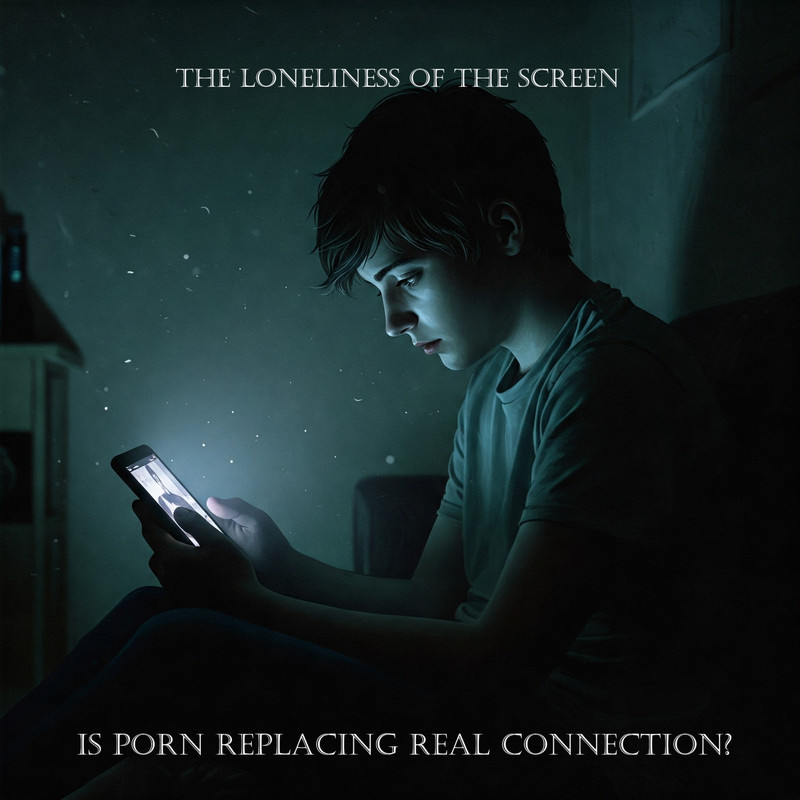The Loneliness of the Screen: Is Porn Replacing Real Connection?
In an Age of Digital Intimacy: Pornography and the Search for Connection
In an age where digital intimacy is just a click away, a growing number of people are finding themselves turning to pornography not just for sexual gratification, but as a substitute for genuine human connection. This trend raises important questions about how our increasingly digital lives are reshaping our most intimate relationships and emotional well-being.
The Digital Intimacy Paradox
The internet has transformed how we access sexual content. What previously required in-person access is now instantly available online through a variety of digital platforms. This unprecedented accessibility has coincided with significant societal shifts:
-
Declining marriage rates
-
People dating and having sex less frequently
-
Reports of increasing loneliness across demographics
The correlation between these trends is complex. While pornography isn't necessarily causing these social changes, its ubiquity may be both a symptom and an amplifier of underlying disconnection.
When Pixels Replace People
For some individuals, frequent use of adult content has shifted from occasional viewing to becoming a significant part of their private experiences. The appeal is understandable: it offers stimulation without rejection, complexity, or vulnerability. Unlike real relationships, digital content doesn't:
-
Judge appearance or performance
-
Require emotional investment
-
Demand reciprocity or compromise
-
Risk disappointment or heartbreak
This frictionless experience creates what some researchers call "supernormal stimuli"—artificial experiences that trigger natural responses but in heightened, simplified ways our biology didn't evolve to process.
The Neurochemical Story
When we consume pornography, our brains release dopamine, oxytocin, and other neurochemicals associated with pleasure, bonding, and reward. These same chemicals facilitate attachment in real relationships, but pornography delivers them without actual human connection.
Some research suggests that for certain individuals, this neurochemical pattern can lead to:
-
Desensitization requiring more novel content for the same effect
-
Difficulty becoming aroused by real partners
-
Conditioning arousal to screens rather than human touch
-
Associating sexuality with isolation rather than connection
However, it's important to note that these effects vary significantly between individuals based on usage patterns, psychological factors, and existing relationship dynamics.
The Relationship Impact
Partners of frequent pornography users sometimes report feeling:
-
Inadequate
-
Betrayed
-
Unable to compete with the idealized images on screen
These feelings can contribute to relationship dissatisfaction and communication breakdowns.
Conversely, some couples report that shared pornography use enhances their intimacy by facilitating communication about desires and fantasies. The impact depends greatly on how pornography integrates with existing relationship patterns and whether both partners are comfortable with its role.
Beyond Binary Thinking
Discussions about adult content often fall into two extremes:
-
Moral concern
-
Casual acceptance
This leaves little room for balanced perspectives. A more nuanced view acknowledges that the effects of adult content vary and largely depend on:
-
How frequently it's consumed
-
Whether it replaces or supplements real intimacy
-
The content's nature and messaging
-
The viewer's psychological patterns and relationship context
-
Cultural and personal values around sexuality
Finding Balance in a Digital Age
For those concerned about their relationship with pornography, several approaches may help restore balance:
-
Mindful consumption: Being intentional about when, why, and how often you view pornography
-
Digital boundaries: Creating tech-free times and spaces to encourage real connection
-
Relationship investment: Intentionally nurturing close connections, even when faced with challenges
-
Open communication: Discussing concerns and boundaries with partners
-
Professional support: Seeking therapy if pornography use feels compulsive or disruptive
The Bigger Picture
The question of whether pornography is replacing real connection points to larger cultural shifts around intimacy, technology, and community. While digital media offers unprecedented access to sexual content, humans still fundamentally crave authentic connection—the kind that involves risk, vulnerability, and presence.
Perhaps our relationship with pornography serves as a microcosm of our broader digital dilemma: learning to harness technology's benefits while preserving the irreplaceable value of human connection. The solution isn't necessarily eliminating digital intimacy but ensuring it complements rather than replaces the messy, challenging, and ultimately more fulfilling work of connecting with real people.
The screen may offer temporary relief from loneliness,but lasting fulfilment still comes from the courage to be truly seen and known by others.

Comments
Post a Comment